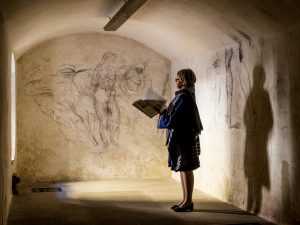The room was found in 1975 by then museum director Paolo Dal Poggetto and colleagues while looking for a new way for tourists to exit, National Geographic reports

After the initial discovery of the room, which was filled with coal, experts undertook the careful job of removing layers of plaster from the walls to reveal what could be hidden beneath, given the city’s history.
And, this revealed dozens of drawings that appeared similar to some of Michelangelo’s famous works.
Among the drawings was an image that resembles a sculpture in the New Sacristy chamber of the chapel, which was designed by Michelangelo, according to National Geographic.
The experts also noted parallels between a particular sketch and the artist’s chalk drawing of the Resurrection of Christ, as well as a sketch reminiscent of Michelangelo’s depiction of Leda and the swan.
Others appear to show humans flying across the walls, or falling from the sky.
Click here to see more images
And, one of the charcoal drawings is thought to be a version of one of the figures in the artist’s paintings at the Sistine Chapel.
The room was found in 1975 by then museum director Paolo Dal Poggetto and colleagues while looking for a new way for tourists to exit, National Geographic reports.
Dal Poggetto and other experts have suggested that Michelangelo hid in the oblong room for roughly two months in 1530.
The artist had previously been commissioned by the Medici family, but betrayed them during their exile in 1527 by aligning himself with others against their rule – a move which later put him at risk, according to National Geographic.
It’s thought that the artwork in the room is a collection of works he’d already completed, and of those he had yet to finish.
But, not all are convinced of this explanation.
The pieces are not signed, and some are considered too ‘amateurish’ to really have been done by the famed artist.
And, Michelangelo was too prominent a figure to have hidden in such a place, William Wallace, a Michelangelo scholar at Washington University in St Louis, told National Geographic.
The expert thinks the drawings were instead done at an earlier time, likely in the 1520s, during work on the New Sacristy.
So, while some may have been done by Michelangelo himself, the expert says others were likely done by some of his many assistants during their breaks.
The room remains closed off to the public, in efforts to preserve the artwork inside.
Read more: http://www.dailymail.co.uk/sciencetech/article-4445372/Secret-room-Italy-contains-lost-Michelangelo-artwork.html#ixzz4fLLe0zPX
Follow us: @MailOnline on Twitter | DailyMail on Facebook
This story first appeared on Mail Online
